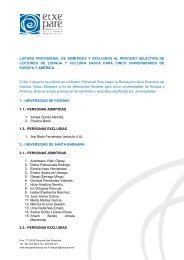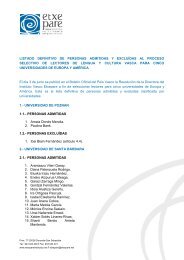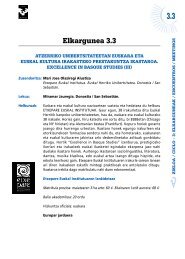Euskal sukaldaritzaz - Etxepare, Euskal Institutua
Euskal sukaldaritzaz - Etxepare, Euskal Institutua
Euskal sukaldaritzaz - Etxepare, Euskal Institutua
Create successful ePaper yourself
Turn your PDF publications into a flip-book with our unique Google optimized e-Paper software.
quien tuvimos la suerte de conocer. A diferencia de<br />
la que aquí hemos puesto, Pildain acostumbraba a<br />
poner un par de cucharadas de salsa de tomate, y<br />
también una de mantequilla para dar brillo a la salsa.<br />
Doy fe de que el recuerdo de aquella salsa sigue<br />
siendo para mí, 25 años más tarde, el canon de la<br />
salsa vizcaína.<br />
La salsa verde del perejil, es seguramente la salsa<br />
que más utilizamos en la cocina doméstica, pues<br />
además de casi todos los pescados blancos, con ligeras<br />
variantes suyas podemos preparar también patatas,<br />
alguna verdura que otra e incluso algún plato de<br />
carne como el de manitas de cordero.<br />
La verde, es una salsa que ha conocido en los últimos<br />
tiempos una sutil evolución que a nadie he oído<br />
mencionar y, sin embargo, resulta del todo cierta.<br />
Hace muy pocos años, la tendencia consistía en dar<br />
sabor y cuerpo a esta salsa, que de por sí es bastante<br />
tenue. Se añadía una considerable cantidad de harina<br />
para engordarla, y para el sabor se le añadía algún<br />
vino local como el txakoli e, incluso, algún jerez seco<br />
que otro. El pescado se comenzaba a cocinar sobre la<br />
grasa (el aceite) y era más tarde cuando se le aportaba<br />
humedad (caldo o agua).<br />
Hoy las cosas ha cambiado mucho, la tendencia es<br />
la opuesta. Sobre todo entre los grandes cocineros.<br />
Ya no se persigue aquella salsa suntuosa y de sabor<br />
forzado, es justo lo contrario lo que se quiere: una<br />
salsa más bien ligera, con la harina justa para ligarla,<br />
con apenas sabor y que no enmascare la calidad del<br />
pescado. Sólo le es permitido el perfume del perejil<br />
recién picado.<br />
Se entenderá mejor lo que decimos sobre esta cuestión<br />
de tratar de no enmascarar el sabor del pescado<br />
si, como sucede, nos referimos a un pescado con<br />
apenas gusto y que es el que con más frecuencia preparamos<br />
con esta salsa: la merluza.<br />
Iturbe includes in the book a recipe by the now deceased<br />
Genaro Pildain, a mythical Bizkaian chef who<br />
I was lucky enough to meet. In contrast to my recipe<br />
here, Pildain used to add a couple of tablespoons of<br />
tomato sauce and a tablespoon of butter (to add a<br />
shine) to the sauce. I can testify that the memory of<br />
that sauce is still, for me, twenty-five years later, the<br />
canon of Bizkaian sauce.<br />
Green sauce made with parsley is without doubt the<br />
sauce that most people use at home. This is because,<br />
besides almost all white fish, with slight variations<br />
among each it can be also be used with potatoes,<br />
any vegetable and even some meat dishes such as<br />
lambs’ hooves.<br />
Green sauce has experienced lately a subtle evolution<br />
about which I have heard few people comment<br />
on, and yet it is quite evident. Just a few years ago<br />
the tendency was to add flavour and body to this<br />
sauce, which in itself is quite mild and runny. Quite<br />
a lot of flour was added to thicken it up, and to add<br />
flavour a local wine, such as txakolina, or even dry<br />
sherry, was incorporated. Fish was fried in oil and<br />
only later was liquid added (stock or water).<br />
Today things have changed considerably and the tendency<br />
is the opposite; especially among the great<br />
chefs. That lavish sauce with its added flavour is the<br />
complete opposite of what people want now: a rather<br />
light sauce with just enough flour to bind it, with<br />
hardly any flavour and which doesn’t hide the flavour<br />
of the fish. The only additional flavour permitted is a<br />
light touch of recently chopped parsley.<br />
One can appreciate this question of not hiding the<br />
flavour of the fish more clearly if, as is the case, we<br />
take as an example a fish with little flavour and one<br />
for which this sauce is the most typical accompaniment:<br />
hake.<br />
With scarcely and aroma or flavour, when cooking<br />
this fish we concentrate on the texture of its thin lay-<br />
65

















